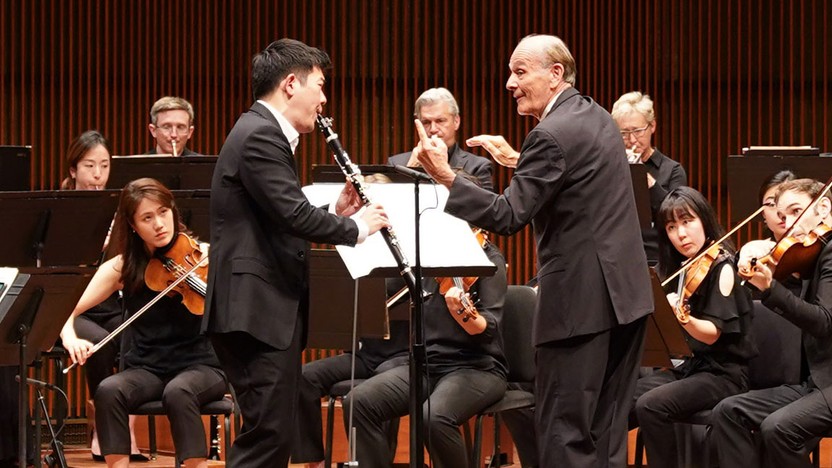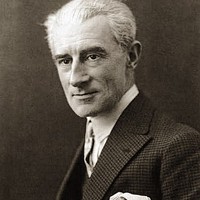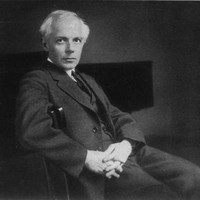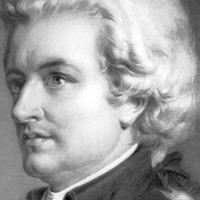Season Finale: Mozart’s Prague Symphony with Gábor Takács-Nagy



“If it could talk, the work would yell ..." So stated one art commentator of painting known as “Gotham News” by Dutch-born American painter Willem de Kooning (born April 24, 1904, Rotterdam, Netherlands — died March 19, 1997, East Hampton, New York, U.S.), who was one of the leading exponents of Abstract Expressionism, particularly the form known as Action painting. Dating from 1955, and measuring 69 x 79 inches, “Gotham News” which is housed in Albright-Knox Gallery in Buffalo, New York, presents a hectic mixed media canvas, a traffic jam of complementary colors, near accidents between red and green, blue and orange, or black and white.
The mottled pink passage near the bottom left suggests the presence of mortal flesh in a world of zigzags and sharp corners. Not only does the work offer insight to the artist's life but also the social context of making art in New York City in the mid-1950s, and, for something so abstract, a good historical picture of New York in the 1950s.
As a metaphor and clued by the work's title, which was coined by curator and arts editor Katherine Kuh as an organizer of the American section for the 1956 Venice Biennale, “Gotham News” expresses through the textural richness of large, thick brushstrokes, the busy energy of New Yorkers in their city. We can read actual text in this painting, from the bits of newspaper transfers which de Kooning applied to the wet paint: top middle - the upside down and reversed newspaper ad - a movie theater notice for Alfred Hitchcock's 1955 movie “To Catch a Thief”, starring Cary Grant and Grace Kelly; scraps of advertisements for diamond wedding rings, clearance sales, a cartoon woman, and something about television. The vigorous painting whips up a controlled chaos, the many voices of the imagined mythic Gotham all at once engaged in the persuasive practices of journalists and ad men.
De Kooning said in an interview with David Sylvester for the BBC in 1962: “The pictures (I have) done since the 'Women', they’re emotions, most of them. Most of them are landscapes and highways and sensations of that, outside the city – with the feeling of going to the city or coming from it. .. I am here and I like New York City. But I love to go out in a car ... I’m just crazy about going over the roads and highways.”
“Gotham News presents a musical response to and allegory of De Kooning’s painting “Gotham News”, exploring and giving sonic representation and colour to the painting’s fascinating content, medium and energy, unravelling the facets and clues to the painting’s expression and landscape through compelling and vigorous textures, dynamic rhythm and harmonic structure, and dexterity of instrumentation.
Geoffrey Gordon ©2025

Maurice Ravel composed the piano solo Pavane pour une infante défunte in 1899, while studying with Gabriel Fauré at the Paris Conservatory. He dedicated the score to a patron who hosted influential salons in Paris, Princess Edmond de Polignac — formerly Winaretta Singer of Yonkers, New York, heir to her family’s sewing machine fortune.
Following its debut performance in 1902, the Pavane became a favorite of amateur pianists in the drawing rooms of Paris and beyond. Ravel accepted the piece’s success with some chagrin, later noting its “excessive influence of Chabrier.” He also complained that people played the piece too slowly — most likely because they misunderstood the title, which translates literally as “Pavane for a Dead Princess.” Ravel said he simply enjoyed the alliterative ring of “infante défunte,” though he also proposed a scenario of a young princess dancing a stately pavane in the Spanish court of a bygone era. Ravel’s orchestral version from 1910 only heightens the nostalgic emotions, starting with a soaring melody entrusted to the ever-regal French horn.
Aaron Grad ©2025

Béla Bartók began his musical career amid a surge of Nationalism throughout Europe, when composers in smaller and less powerful countries sought to express the identities of their own lands and people. This process had already started in Hungary through the efforts of Franz Liszt and Ernő Dohnányi, but for students at the Budapest Academy, where Bartók graduated in 1903, the tradition-bound curriculum was really no different than what a student might have encountered at the Vienna Conservatory.
The revelation that led Bartók toward a true Hungarian sound came in 1904, when he overheard a maid singing a folksong at a resort in what is now Slovakia. He and his former classmate Zoltán Kodály embarked on a quest to record all the folk music they could find in villages and rural outposts all over the region, capturing authentic performances on primitive wax cylinders. Ultimately Bartók helped collect and catalog some 14,000 folksongs, and his research gave rise to the academic field of Ethnomusicology. Meanwhile these ancestral melodies seeped into Bartók’s musical consciousness, and his own composing became a prime meeting ground between the old German-Austrian lineage of concert music and the even older history of communal music-making in Central Europe.
In the String Quartet No. 1, composed in 1908-09, Bartók was testing the boundaries of traditional tonal harmony. The slow first movement is a sober statement built upon distinctive intervals and patient counterpoint between voices, underscoring Bartók’s lifelong obsession with symmetry and contrapuntal layering. By tradition, this slow music should have served as an introduction to faster music, but Bartók instead developed it as a self-contained statement within a three-movement form.
Reached through a linking passage, the scherzo-like middle movement once again focuses on manipulating compact cells, demonstrating Bartók’s respect for the precedent that Ludwig van Beethoven set in his taut, obsessive quartets. With its repeated notes and pulsing rhythms, the fast and lively finale comes closest to channeling the dancing drive of Hungarian folk music, but still the overarching concern is motivic interplay. The version heard here, created by SPCO Artistic Partner Gábor Takács-Nagy, assigns the quartet’s music to full string sections.
Aaron Grad ©2025

Immersed in the magical cultural milieu of Belle Époque Paris at the end of the 19th century, the precocious talent of young composer Reynaldo Hahn (August 9, 1874 – January 28, 1947) emerged, and from an early age, Hahn astounded and delighted his audiences with settings of some of the most beautiful and enduring poems of contemporary writers, including Hugo, Verlaine, Mallarmé. It is said that Verlaine "wept to hear Hahn's songs" and Mallarmé wrote: "Le pleur qui chante au langage du poète, Reynaldo Hahn, tendrement le dégage comme en l'allée un jet d'eau." (“The cry that sings to the language of the poet, Reynaldo Hahn, tenderly releases it like a jet of water in the alley.”)
Inspired by and in recognition of Hahn’s legacy, composer Geoffrey Gordon re-imagines, through his own distinct and intensely expressive musical language, the beguiling atmosphere, adventurous harmonic progressions and profound beauty of Hahn’s exquisite and contemplative chanson, “Fumée” (“Smoke”) — first published by Paris Heugel (1896) — in the form of an alluring and intense new concerto for Bb clarinet and chamber orchestra. Echoing and amplifying Hahn’s setting of the text by Jean Moréas, the concerto idiomatically addresses the poet’s message of a life that goes from ashes to ashes, envying the freedom and transience of smoke which has no past, no responsibility, and is without the hardships of life ... vanishing into the ether.
Geoffrey Gordon ©2024
 Listen to Audio
Listen to Audio
First performance January 19, 1787 in Prague.
While in Prague in 1787 to attend a production of The Marriage of Figaro, Wolfgang Amadeus Mozart introduced his first new symphony in three years. He had wanted to visit London that season, and he may have begun the symphony in anticipation of such a trip, but the journey stalled when his father refused to provide childcare. The less ambitious trip to Prague proved valuable anyway, since Mozart secured the opera commission that would result in Don Giovanni. At a time when his star-power in Vienna was waning, Mozart soaked up the adoration he received in Prague, where he purportedly said, “My Praguers understand me.”
The “Prague” Symphony in D Major is one of only three Mozart symphonies with a slow introduction. Foreshadowing similar angst in Don Giovanni, the weighty opening broods over tense music in the key of D-minor. The fast body of the movement counters with a breathless energy akin to the overture from The Marriage of Figaro, with running sixteenth-notes and surprising dynamic contrasts.
The central Andante movement colors the first theme of its sonata form with vertiginous, rising chromatic scales. Later, the development section churns this material through a wide array of keys and moods. The symphony forgoes a minuet and proceeds directly to the finale, which quotes the portion of The Marriage of Figaro where Susanna tries to rush the love-struck page, Cherubino, out the window. It is a fitting sendoff for such a drama-filled symphony, and it must have delighted those Praguers who gobbled up Figaro and all things Mozart.
Aaron Grad ©2025
Get driving directions and find nearby parking.
Find dining options close to the venue.
View seating charts to find out where you'll be seating.
SPCO concerts are made possible by audience contributions.
For exclusive discounts, behind-the-scenes info, and more:
Sign up for our email club!
